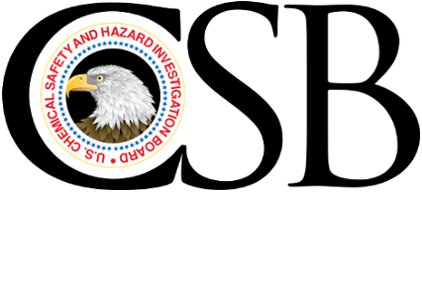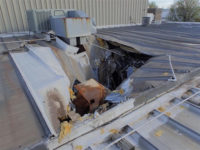CSB: Chemical safety facility improvement is in slow-mo
“Recommendations have yet to be acted upon”

 Statement by Christina Morgan, U.S. Chemical Safety Board (CSB) Recommendations Specialist, at a public hearing on Executive Order 13650: Improving Chemical Facility Safety and Security, November 15, 2013.
Statement by Christina Morgan, U.S. Chemical Safety Board (CSB) Recommendations Specialist, at a public hearing on Executive Order 13650: Improving Chemical Facility Safety and Security, November 15, 2013.
On behalf of the U.S. Chemical Safety Board, thank you for this opportunity to speak at today’s public listening session regarding the need to modernize key policies, regulations, and standards to enhance safety and security in U.S. chemical facilities.
The CSB’s legislative mandate specifically directed the CSB to issue recommendations “to reduce the likelihood or the consequences of accidental releases and proposing corrective steps to make chemical production, processing, handling, and storage, as safe and free from risk of injury as possible.” To that end, since 1998 the Board has issued a number of recommendations to the Occupational Safety and Health Administration (OSHA), and the Environmental Protection Agency (EPA). Several important regulatory recommendations to these agencies remain unaddressed, and therefore critical safety gaps the CSB identified in OSHA’s Process Safety Management (PSM) regulation and EPA’s Risk Management Program (RMP) regulation remain.
Uncontrolled reactivity
For example, in the fall of 2002, the Board released its comprehensive study on the management of reactive chemical hazards. Incident data analyzed by the CSB at that time identified 167 serious incidents in the United States involving uncontrolled reactivity between 1980 and 2001. Nearly a third of them affected the public, and more than half involved chemicals that were not, and still are not, covered by PSM or RMP. Therefore, the Board issued recommendations to both OSHA and EPA calling for revisions to these standards that would achieve more comprehensive control of reactive hazards. But those recommendations have yet to be acted upon.
The April 2013 devastating explosion at the West Fertilizer Plant in Texas, which claimed the lives of fifteen people, many of them volunteer firefighters, demonstrated all too clearly that reactive chemicals threaten not only the safety of workers, but of the public at large. It also made clear that the PSM and RMP regulations must be updated to better safeguard against major chemical incidents in our country.
For that reason, the Board appreciated OSHA’s announcement in the Spring 2013 Semiannual Agenda of Regulations that the agency is considering revisions to PSM that would “expand coverage and requirements for reactivity hazards.” We are hopeful that EPA will take similar actions to ensure its RMP regulation also addresses these hazards.
Ten years later...
The Board is also pleased that OSHA is considering additional revisions to the Process Safety Management standard which would address the standard’s exemption for atmospheric storage tanks. Following our investigation of the July 2001 sulfuric acid tank explosion that killed a worker at the Delaware City refinery, the Board recommended that OSHA ensure coverage under PSM for atmospheric storage tanks that could be involved in a catastrophic release as a result of being interconnected to a PSM-covered process. More than ten years later, this recommendation has not been implemented, and the Board remains concerned that such tanks remain exempted from important process safety and mechanical integrity requirements prescribed by the PSM standard. We support OSHA’s willingness to address this safety gap and further our shared goal of preventing future chemical incidents.
Poorly managed corporate mergers
The Board is also appreciative of OSHA’s consideration of revisions to the PSM standard that would address the applicability of the standard’s Management of Change (MOC) analysis requirements to organizational changes which may impact process safety. In investigating the March 2005 explosions and fires at the BP Texas City refinery that killed 15 workers, the CSB found that poorly managed corporate mergers, leadership and organizational changes, and budget cuts greatly increased the risk of catastrophic accidents at the site. The CSB therefore recommended that OSHA amend the PSM standard to make clear that these organizational changes should trigger MOC analyses. We are hopeful that OSHA will address this issue in its potential rulemaking.
Financial and human costs
As this working group continues its efforts to improve chemical facility safety and security in the United States, the Board urges both OSHA and EPA to consider how existing regulations may be modernized to incorporate an inherent safety approach to chemical hazard management. The industry generally agrees that inherently safer operations can be achieved through four principles. These are: substituting one material with another that is less hazardous, minimizing the amount of hazardous material being used, moderating process conditions by lowering pressures and temperatures, and designing processes to be less complicated, and therefore less prone to failure. Some in industry have opposed mandatory IST programs because retrofits and updated processes can be expensive to implement. However, the financial and human costs of chemical explosions and fires - and the costs of preparing a community for the worst case - need to be part of any decision process.
The CSB is also currently examining, and urges this working group to examine, the potential benefits of alternative regulatory regimes for improving chemical facility safety. The safety case regime requires high hazard facilities to demonstrate, to the satisfaction of the regulator, that they can operate safely and in conformance with the latest industry standards and achieve the lowest practical risk levels. This approach provides industry the opportunity to tailor regulations to its specific facilities with the goal of continuous risk reduction and major accident prevention. The safety case regime also places the impetus on industry to evolve with current best safety practices, thereby eliminating the need for the regulator to constantly revise and update regulations to keep them current and relevant. This system is, of course, predicated on the existence of a well-funded and competent regulator.
Looking for a reprint of this article?
From high-res PDFs to custom plaques, order your copy today!







.jpg?t=1721257160)

